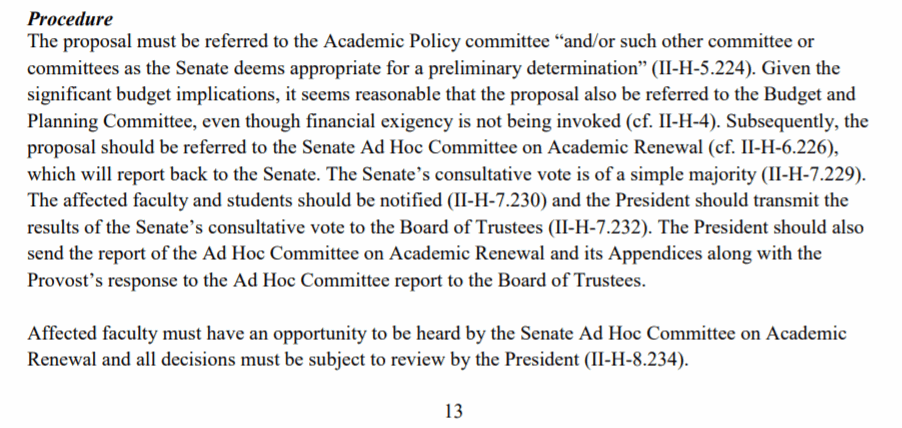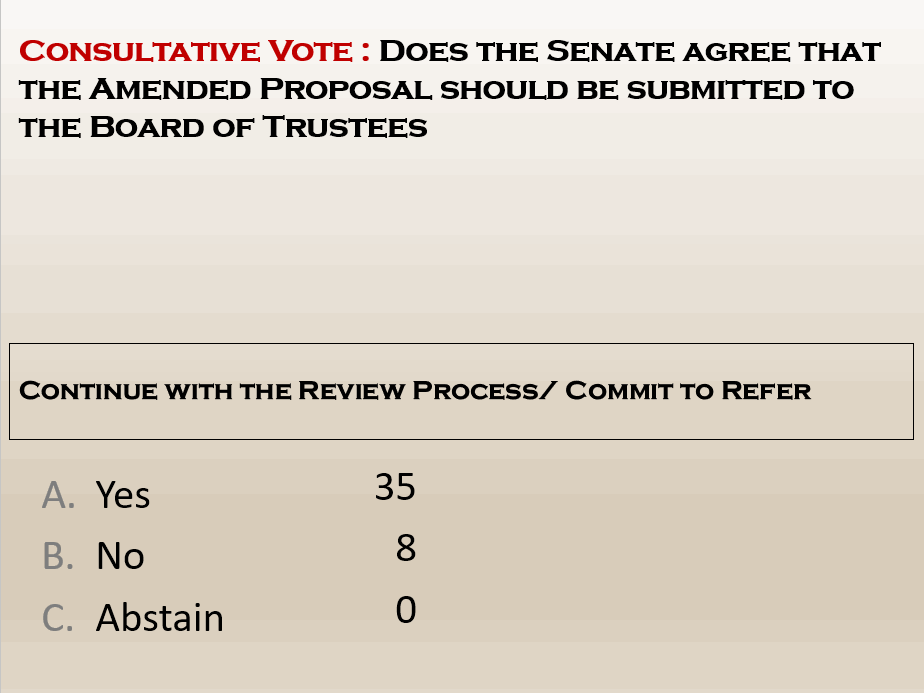One thing is clear: on May 9, 2018, the Academic Senate voted on a Proposal for Academic Renewal.
The vote was, however, quite odd. It was, as the slide from the meeting (below) says, “consultative,” meaning that whatever the vote–affirmative or negative–the Provost could send it on to the Board of Trustees. Of course, the Provost wanted a positive vote, and in the end he was willing to pay for it, by eliminating all references to firing tenured faculty and by ditching the caste system for faculty.
Getting the stripped-down proposal passed was a victory for the Provost. But stripping it down was a victory for the faculty.
The language of the vote was the weakest language possible: “Does the Senate agree that the amended proposal should be submitted to the Board of Trustees?”
What does this actually mean? Is it asking whether the proposal has merit? whether the Senate approves of what it proposes? Or is it merely stating that the Senate is done with the proposal, and it is now time to move on to the next step in the process?
Note that on the slide from the Senate meeting (below), the heading for vote tally indicates that “Yes” means “Continue with the Review Process.” That is, “Yes” is a vote to send the proposal to the next stage in the review process, which is with the Board of Trustees. “No” is for “commit to [sic] refer,” meaning that the proposal stays in the Senate and goes back to the committee.
So the members of the Senate had the invidious choice between “Yes, pass along the proposal to the trustees” or “No, we’ll keep on working on it.” Talk about damned if you do, damned if you don’t.
The is analogous to the bizarre charge the Provost gave the Ad Hoc Committee with its three choices: approve as it, approve with changes, or write your own proposal. Neither the Ad Hoc Committee nor the Senate had the option simply to reject the proposal–the only logical choice for something so fundamentally flawed.
As the Provost is wont to say whenever anyone objects to anything he proposes, “What would you do instead?” He seems oblivious to the fact that he is the one getting paid the big bucks to come up with proposals, not us. His position is that we aren’t allowed to fault his work unless we are willing to do it for him.
Just as the proposal makes no sense–built on false premises (demographic catastrophe), issuing in illogical conclusions (cutting faculty will make us academically stronger)–the Senate vote made no sense. It was a vote on an ambiguous question, whose ambiguity was intended, no doubt, to get a vote that could subsequently be spun as “approval.”
The vote in the Senate was as bogus as the proposal itself. The Provost needed to have a vote, according to the Faculty Handbook. He didn’t need to win it, since it was merely consultative, but he wanted to win it so that he could claim that the Senate “approved” the proposal.
To be clear, the Senate did not approve the proposal the Provost originally submitted. Neither did it “approve” the amended version it voted on. What it clearly did approve, and indeed insisted on, was sending the Board of Trustees the damning report from the Ad Hoc Committee, which it is safe to say, enjoys virtually universal support by the faculty.
Of course, the President and Provost immediately declared victory (see below) and claimed the vote as an overwhelming “approval” by the Senate. They tout the number of votes, 35 to 8. Their numerical precision is not, however, matched by their verbal precision. The President would have been correct in saying that the Senate “agreed to submit an amended version of the Provost’s proposal to the Board of Trustees.” Simply saying that the Senate “approved” the proposal is disingenuous and insulting.
The faculty, working in a Senate in which it is grossly underrepresented, succeeded in “mutilating” the proposal and sending along a “neutered” version to the Board of Trustees (again, in the Provost’s own words). The Provost paid quite a price; maybe its only right to have pity and let him crow a bit.
Readers may recall the story of Solomon, who in his wisdom settled a dispute between two women who each claimed a child as their own. Solomon passed a decision to cut the child in half to settle the dispute. This left the true mother with no choice but to renounce her motherhood to preserve the life of her child.
This review process employs the techniques of Solomon, but without any of his goodness or wisdom.
Slides from the Academic Senate meeting on May 9, 2018
From p. 13 of the “Proposal on Academic Renewal”
The President’s message from May 9, just after the Senate meeting.
From the Provost’s May 15, 2018 Faculty Newsletter


